Growing Strong
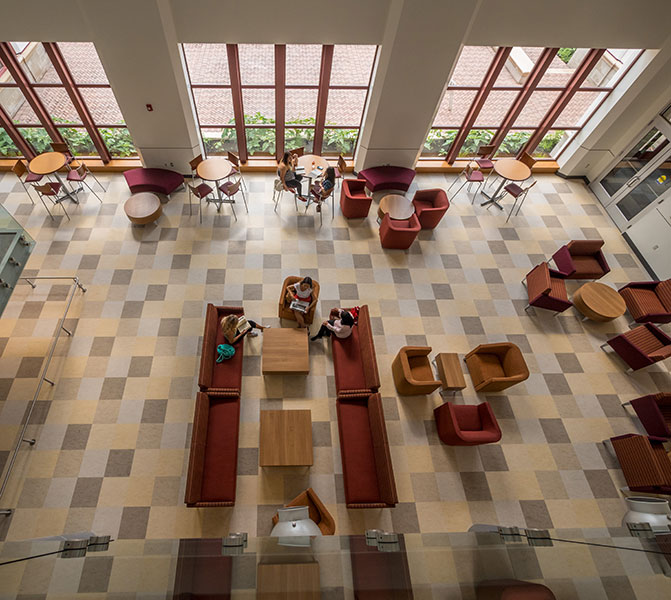
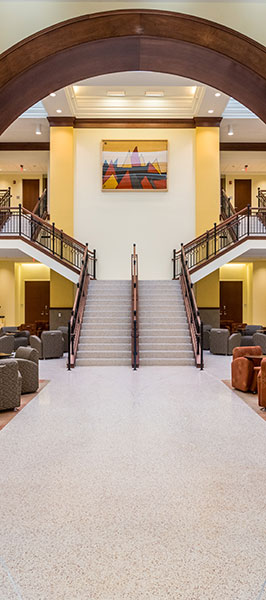
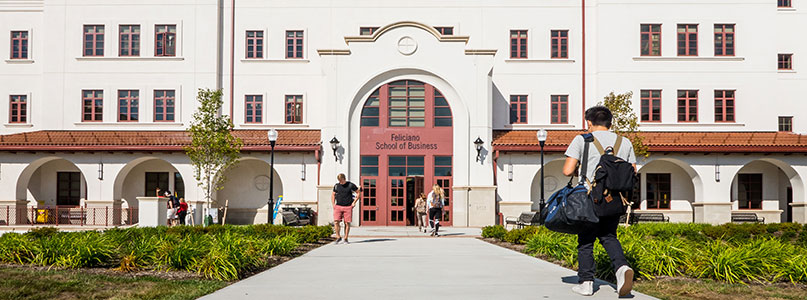
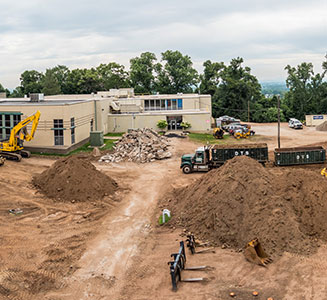
Photos, clockwise from top left: The lobby of the new Center for Environmental and Life Sciences; the new Feliciano School of Business atrium and its front entrance; and construction on the site of the future School of Communication and Media.
University flourishes with new programs, new buildings and more students than ever
In 1910, 45 students graduated from the New Jersey State Normal School at Montclair. Fast forward to 2015, when Montclair State University conferred 4,616 undergraduate and graduate degrees – more than double the number conferred just 15 years ago – the largest class in its history.
The increase in graduates correlates with record-breaking enrollment of more than 20,000 students and is due in part to continually expanding degree programs, course offerings and campus facilities.
According to President Susan A. Cole, this unprecedented growth spurt is the result of years of careful planning. “These results are not happenstance. We planned, we worked and we adjusted our plans based on our growing experience and knowledge and the demands and opportunities of a rapidly changing world. And then we worked even harder,” she says.
Room to grow – and discover
Two brand-new and eagerly anticipated academic buildings – the Center for Environmental and Life Sciences (CELS) and the new Feliciano School of Business building – are proof of strong campus growth. The buildings, which represent a combined investment of $121 million, were partially funded by the State of New Jersey “Building Our Future” Bond Act approved by voters in November 2012.
“By continuing to follow our plan, we will grow even smarter and stronger.”
President Susan A. Cole
This fall, students, faculty and staff moved into the state-of-the-art laboratory and research space in the $55 million, 107,500-square-foot CELS building, which has increased the University’s science research space by 50 percent. Stefanie Brachfeld, chair of the Department of Earth and Environmental Studies and director of the interdisciplinary doctoral program in Environmental Management says, “The building is a tangible symbol of the commitment that the University and voters have made to keeping science education and research strong in New Jersey.”
College of Science and Mathematics Dean Robert Prezant agrees. “CELS is a game changer with remarkable facilities that will enhance the education of our students,” he says. “It was designed with the input of dozens of faculty scholars to ensure premium research and teaching laboratories, extensive space for student study and socializing – and to create a comfortable environment for all phases of discovery.”
Students like Hayley Rosado and Melissa Hansen who worked in the new labs during the summer applaud the new Center. “The open network floor plan really encourages interdisciplinary communication and collaboration,” says Hansen.
Biology professor and director of the Passaic River Institute, Meiyin Wu, notes that CELS is tailored to fit the needs of the University’s rapidly expanding sustainability, environmental and pharmaceutical and life sciences programs. “It provides the much-needed space and equipment to continue this growth into the future,” she predicts.
“The new CELS building is an exceptional place to house our Sustainability Science program,” notes Earth and Environmental Studies Professor Robert Taylor, who coordinates the Sustainability Science program. “It’s a LEED building that adheres to fundamental precepts of green development to provide a truly practical laboratory for sustainability studies.”
John Siekierka, chemistry and biochemistry professor and director of Montclair State’s Sokol Institute for Pharmaceutical Life Sciences, agrees. “The new facilities greatly expand our research capabilities in the pharmaceutical sciences and will help us create new collaborative opportunities with industry and our students and faculty,” he says.
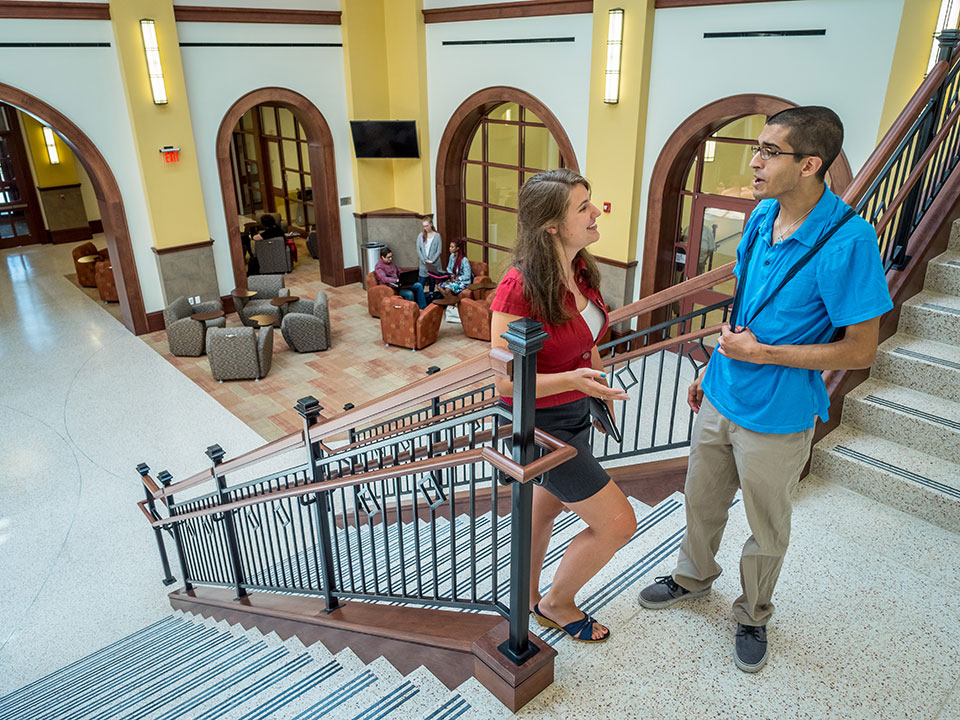
The Feliciano School of Business atrium is a popular place for business students to study.
University of the future
In September, the University unveiled its $66 million home for the renamed Feliciano School of Business, the first major project completed under the “Building Our Future” Bond Act.
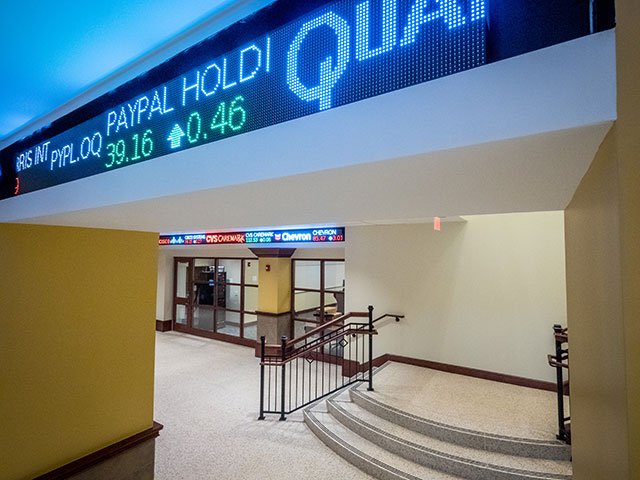
The Feliciano School of Business has its own stock market ticker.
Designed to support the School’s core mission of developing talent for a changing world, the 143,000-square-foot facility provides a high-tech setting for challenging programs that will prepare 2,800 business students to become tomorrow’s business leaders.
Building features include a 150-seat, theater-style lecture hall, interview rooms for corporate recruiting, a 3D printing innovation lab, a cutting-edge financial trading floor for analyzing real-time market data, and more. It is also home to the innovative Feliciano Center for Entrepreneurship.
“Some commentators argue that the university of the future will be based around a virtual campus,” says Feliciano School of Business Dean A. Gregory Cant. “While I would be the first to agree that tomorrow’s campuses will be different from what we experience today, our new fully integrated, high-tech building gives us the essential tools to create outstanding collaborative learning environments as we continue to innovate in the future.”
Coming attractions
The next major addition to campus is currently under construction: a $59 million, 60,000-square-foot School of Communication and Media building. “In addition to bringing together students, faculty and facilities currently spread throughout the campus, the new building will give the School an up-to-the-minute center that will encourage new modes of learning and production,” says School Director Merrill Brown. “It will be as lively and creative as our inventive programs.”
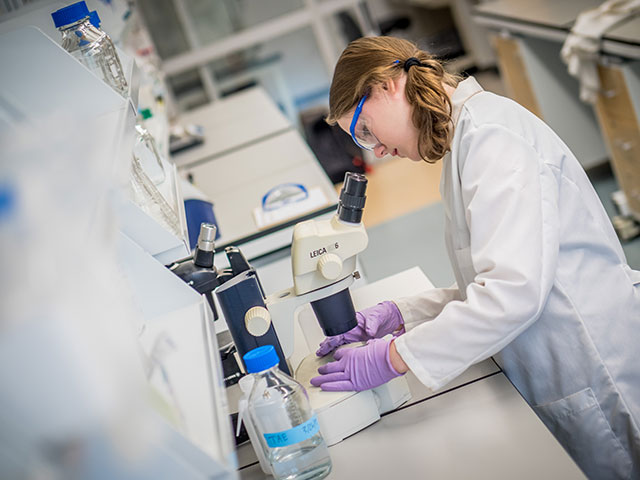
The Center for Environmental and Life Sciences has state-of-the-art labs.
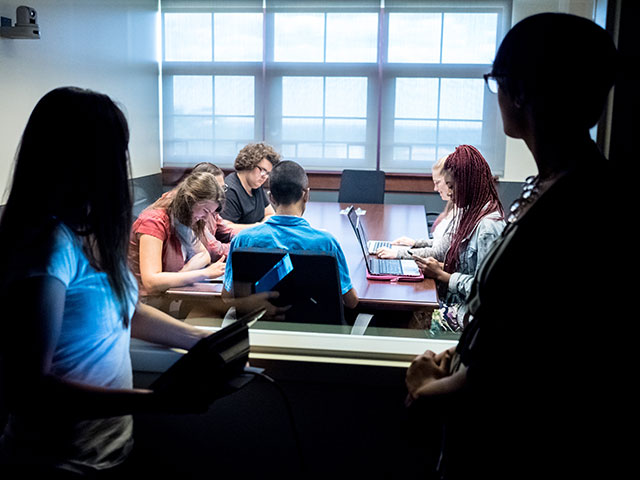
Students can reserve meeting space in the Feliciano School of Business.
If all that weren’t enough, according to the Office of the Provost, the University has embarked on numerous exciting new academic programs and initiatives that fuel growth – and student success.
The College of Science and Mathematics’ successful new Continuing Education for Environmental Professionals (CEEP) program is the model for future continuing education initiatives. CEEP is meeting environmental professionals’ needs with numerous credit-bearing courses as well as programs designed for the larger environmental community.
The Feliciano School of Business, too, has developed several new successful certificate programs. This fall, Montclair State became the first area university to offer business students the opportunity to earn graduate-track certificates in Forensic Accounting. Students can now also concentrate in Business Analytics. And during the 2014–2015 academic year, the Feliciano Center for Entrepreneurship introduced its innovative, multi-disciplinary Certificate of Entrepreneurship. Programs in Human Resource Management and Project Management are on the drawing board.
Launched last fall, the School of Communication and Media’s Bachelor of Arts program in Journalism equips students with the skills they need to deliver compelling and informative content across an evolving, multi-platform media landscape.
The College of the Arts continues to add to its menu of creative programs. In spring 2016, it will offer a two-year, low-residency MFA in Dance program that will give mid-career dance artists, teachers and professionals the knowledge and skills they need for career development and expansion.
An exciting new master’s-level program in Clinical Forensic Psychology offered by the College of Humanities and Social Sciences combines online and in-residence teaching to meet the needs of graduate students and practicing professionals wishing to focus on either criminal or civil family law.
The College of Education and Human Services has recently introduced a new MS degree program in Athletic Training and has created a new post-bachelor’s certificate program in Educational Assessment.
Looking ahead
Doctoral programs – like New Jersey’s only PhD in Communication Sciences and Disorders, which will launch in fall 2016 – reflect Montclair State’s deep commitment to strategically growing its academic offerings and strengthening its position as a leading New Jersey public research university.
Creating educational pathways that build on distinctive institutional strengths enables the University to provide richer educational opportunities.
This past year, the College of Science and Mathematics converted its EdD program in Mathematics Education to a PhD program.
Coordinated program growth also results from smartly conceived collaborative partnerships with schools such as SUNY College of Optometry that give students access to training in optometry. “Reaching out to sister institutions to create educational pathways that build on distinctive institutional strengths enables the University to provide richer educational opportunities for our students,” says Cole.
At the same time, the University continues to think big. It is expanding its reach by working to establish a School of Nursing and related degree programs beginning in fall 2016, and will renovate Partridge Hall to accommodate the School.
Montclair State today is not only growing bigger than ever – it is also growing stronger. “We have measured our progress toward our goals,” says Cole. “We had a plan; we followed our plan. By continuing to follow our plan, we will grow even smarter and stronger.”
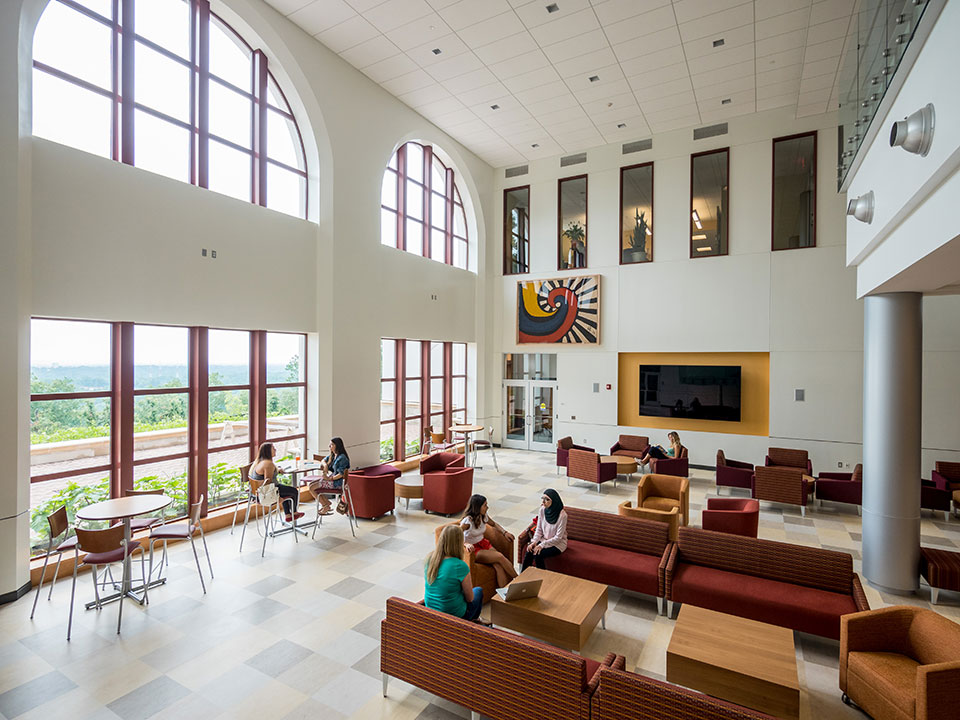
The lobby of the Center for Environmental and Life Sciences offers lounge and study space and views of New York City.